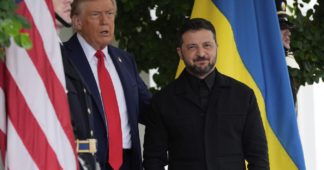Ted Snider
Oct 24, 2025
The president has recaptured the spirit of Alaska.
Ukraine’s President Volodymyr Zelensky walked into the White House last Friday for a meeting with President Donald Trump. He was feeling confident after two “very positive and productive” phone calls with Trump, calls which gave him hope that, for the first time, Ukraine might obtain cruise missiles with a range sufficient to strike deep inside Russia. The Ukrainian leader’s confidence seemed justified. Trump had told reporters that he might tell President Vladimir Putin of Russia, “Look, if this war is not gonna get settled, I may send them Tomahawks.”
And yet, after the White House meeting Zelensky was feeling “very negative,” according to one European official who spoke to the Financial Times. Trump told the Ukrainians that he will not be providing them long-range Tomahawk missiles, at least for now, so Zelensky walked out empty handed, his hopes dashed.
While the mainstream media focused on Trump’s refusal to provide Tomahawk missiles to Ukraine, that was not the big story. After all, Trump was never going to give Tomahawks to Ukraine at this time, for four reasons.
The first is that the U.S. needs all the Tomahawks it has, so it can’t afford to send many to Ukraine. The U.S. produces fewer than 200 a year and has purchased only 202 since 2022. The military went through at least 124 in recent conflicts with Iran and the Yemeni Houthis. Restocking is not only slow but expensive: Tomahawks cost at least $1.7 million each. When Zelensky told Trump that “we need Tomahawks,” Trump replied, “We want Tomahawks also. We don’t want to be giving away things that we need to protect our country.”
The second reason is that Ukraine does not currently possess any of the platforms capable of launching Tomahawk missiles. Though some solution could possibly be engineered, it likely would take too much time. There are land-based Typhon launchers that the U.S. could send Ukraine, but very few are now available.
The third reason is that Tomahawks, even if Ukraine could launch them, would not provide a magic bullet for improving the battlefield situation. Though the missiles are long-range and precise, the U.S. could not provide Ukraine with enough to alter the course of the war. Military experts also say that, if the U.S. can spare anything, they are most likely to part with older Tomahawk models, which Russian air defenses are quite capable of intercepting. Putin told Trump on their recent phone call that “Tomahawks wouldn’t change the situation on the battlefield, but would harm U.S.–Russian relations and the peace process.”
Trump’s refusal to provide Tomahawks to Ukraine was, for all these reasons, predictable and hardly a big news story. The real news was that the Trump pendulum has swung back to the Alaska summit position that Ukraine must give up territory to Russia to end the war.
The reversal is somewhat surprising. In late September, Trump posted on Truth Social that “Ukraine is in a position to fight and WIN all of Ukraine back.” He was brought to this conclusion by two premises: that Russia had failed to make significant territorial gains since the war began and that Russia was in big economic trouble. In his meeting with Zelensky, Trump rejected both premises and reversed his conclusion.
But in the meeting last week, Zelensky faced a very different Trump. When Zelensky once again showed Trump the map, Trump threw the map aside and said he was “sick” of seeing it. In what reportedly became a “shouting match,” Trump told Zelensky that “If [Putin] wants it, he will destroy you.”
Trump also deflated Zelensky’s economic argument that a struggling Russian economy would soon force Russia to switch from fighting to negotiating, telling the Ukrainian president that Russia’s economy is “doing great.”
The return to the position that Ukraine must cede territory to Russia to end the war was not just an off-the-cuff remark by Trump. Behind the closed doors of the meeting, Trump’s special envoy, Steve Witkoff, was “press[ing] the Ukrainian delegation about handing over Donetsk,” while Trump was “urg[ing] Volodymyr Zelenskyy to accept Russia’s terms for ending its war.” Trump would later tell Fox News that Putin is “going to take something, he’s won certain property.”
Explaining what that “something” might be, Putin reportedly told Trump that Moscow “would be willing to surrender parts of two other regions of Ukraine [it] has partly conquered, Zaporizhzhia and Kherson, in exchange for full control of Donetsk.”
Though the refusal to sell Tomahawk missiles to Ukraine captured the media spotlight, the more significant, and more unexpected, news is that Trump’s policy pendulum seems to have swung back to pushing to end the war through a negotiated settlement. The president seems again to recognize that Ukraine cannot win back all its land and will have to cede some territory to Russia. For those worried about U.S.–Russia escalation and pessimistic about Ukraine’s chances of victory, the swing back to Alaska is a welcome development.











